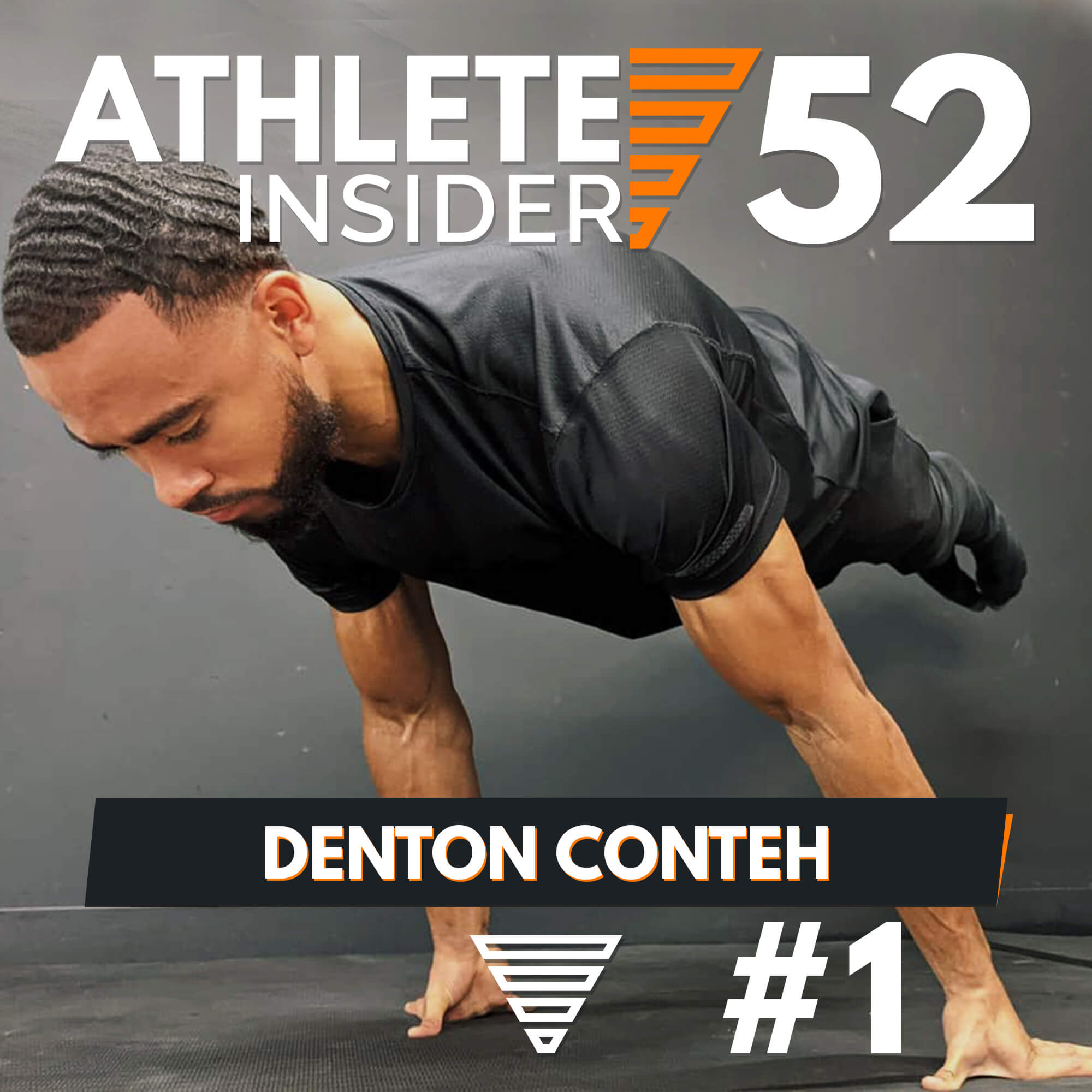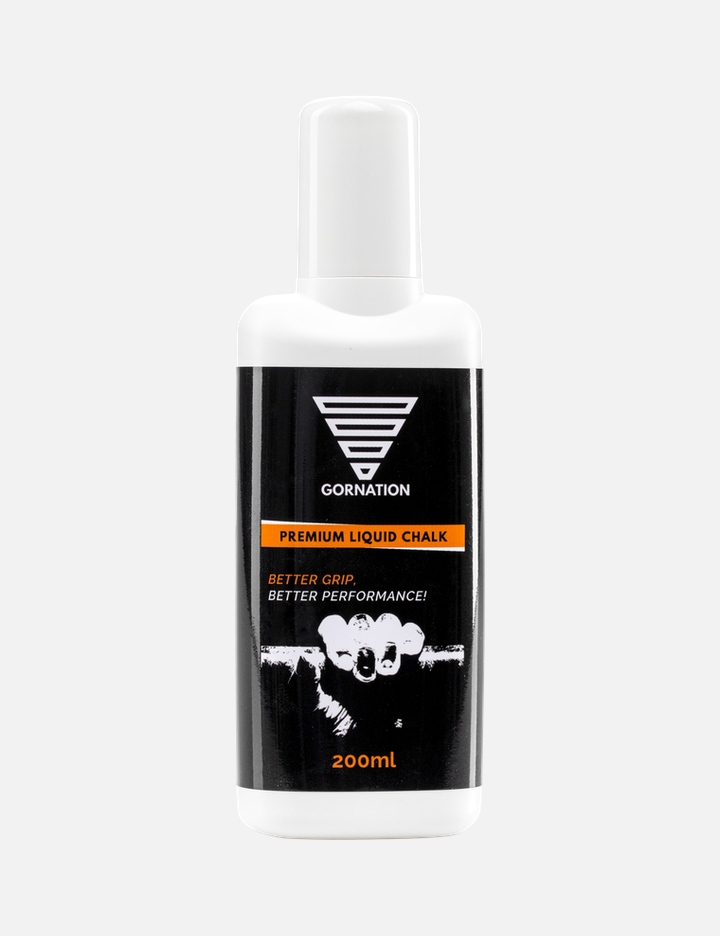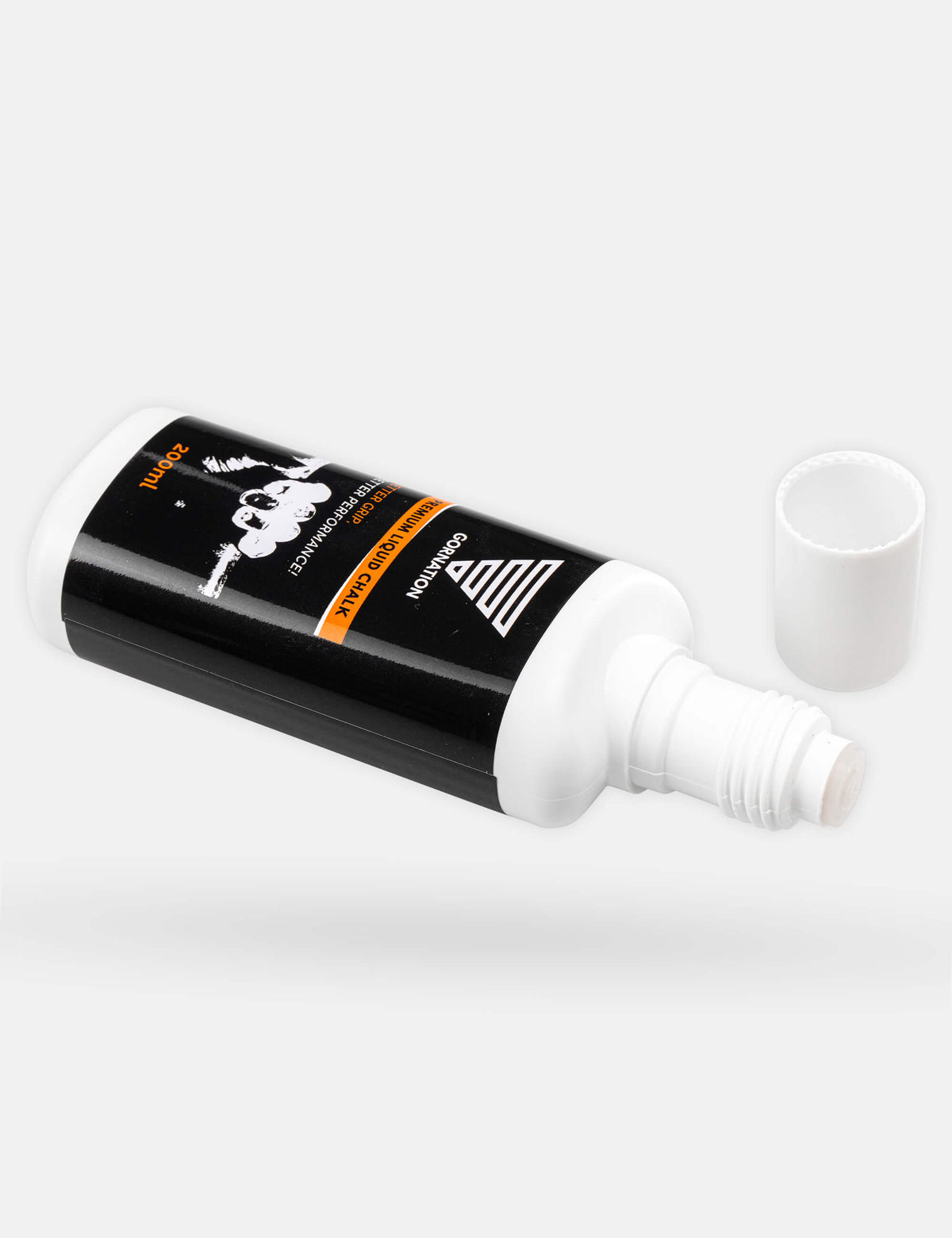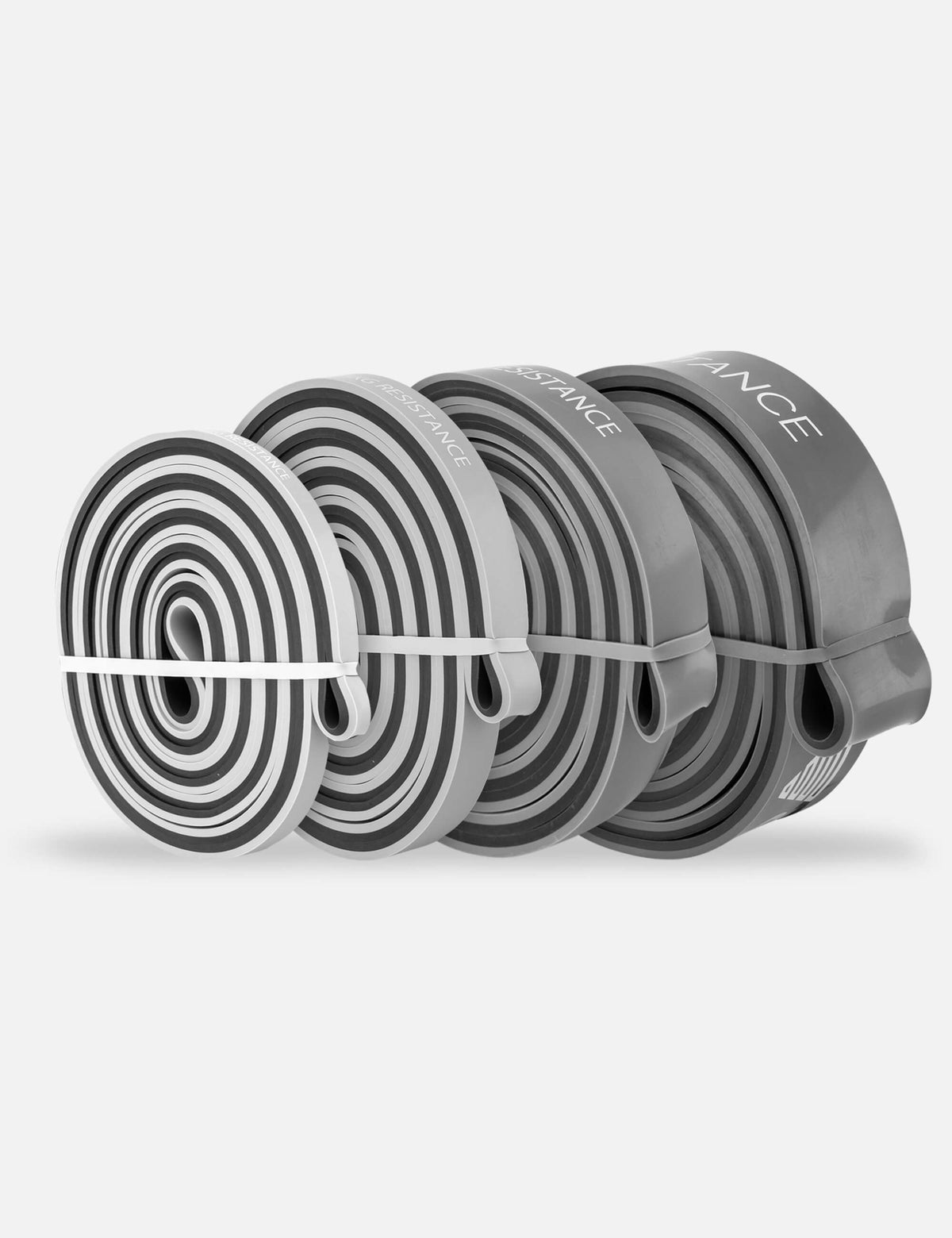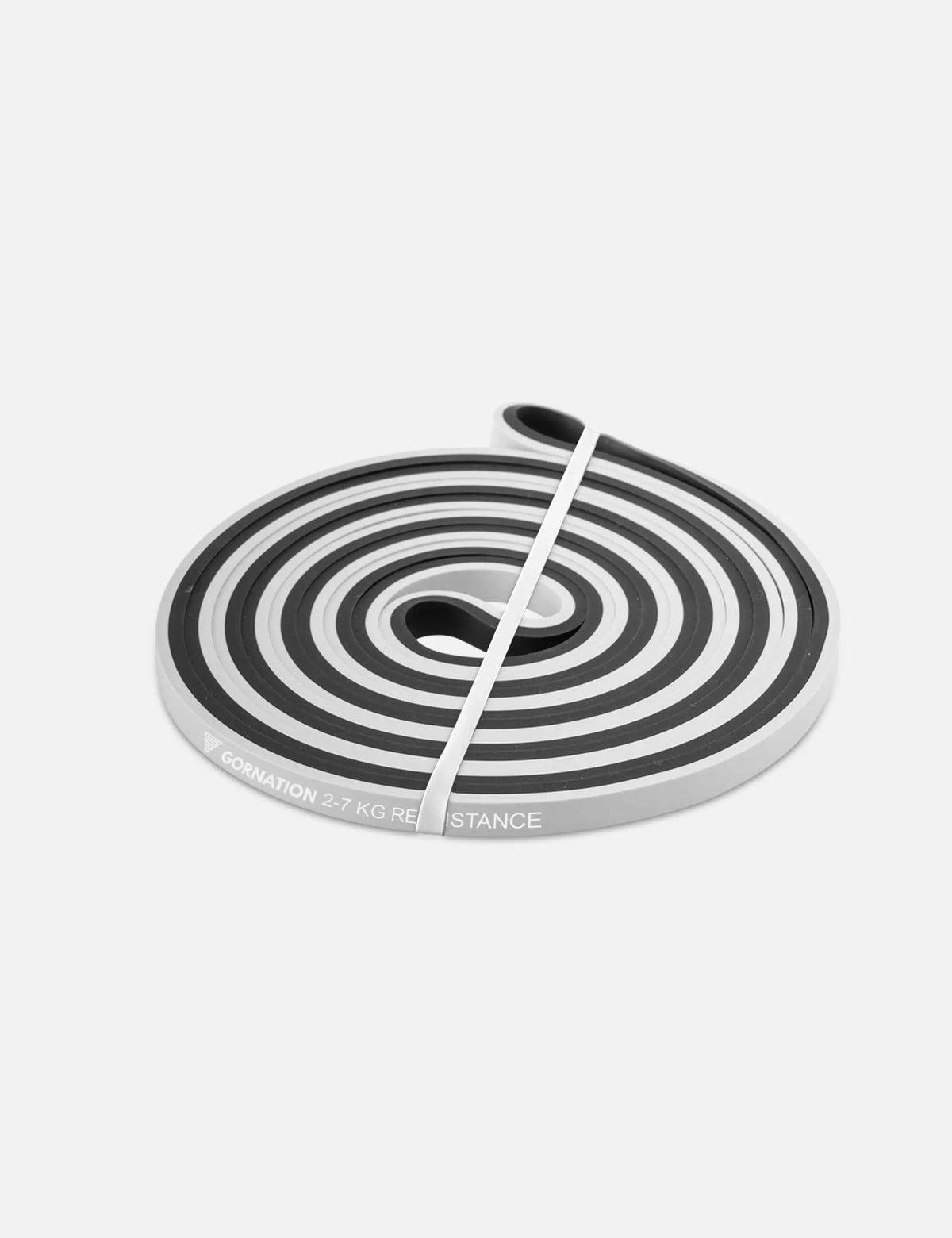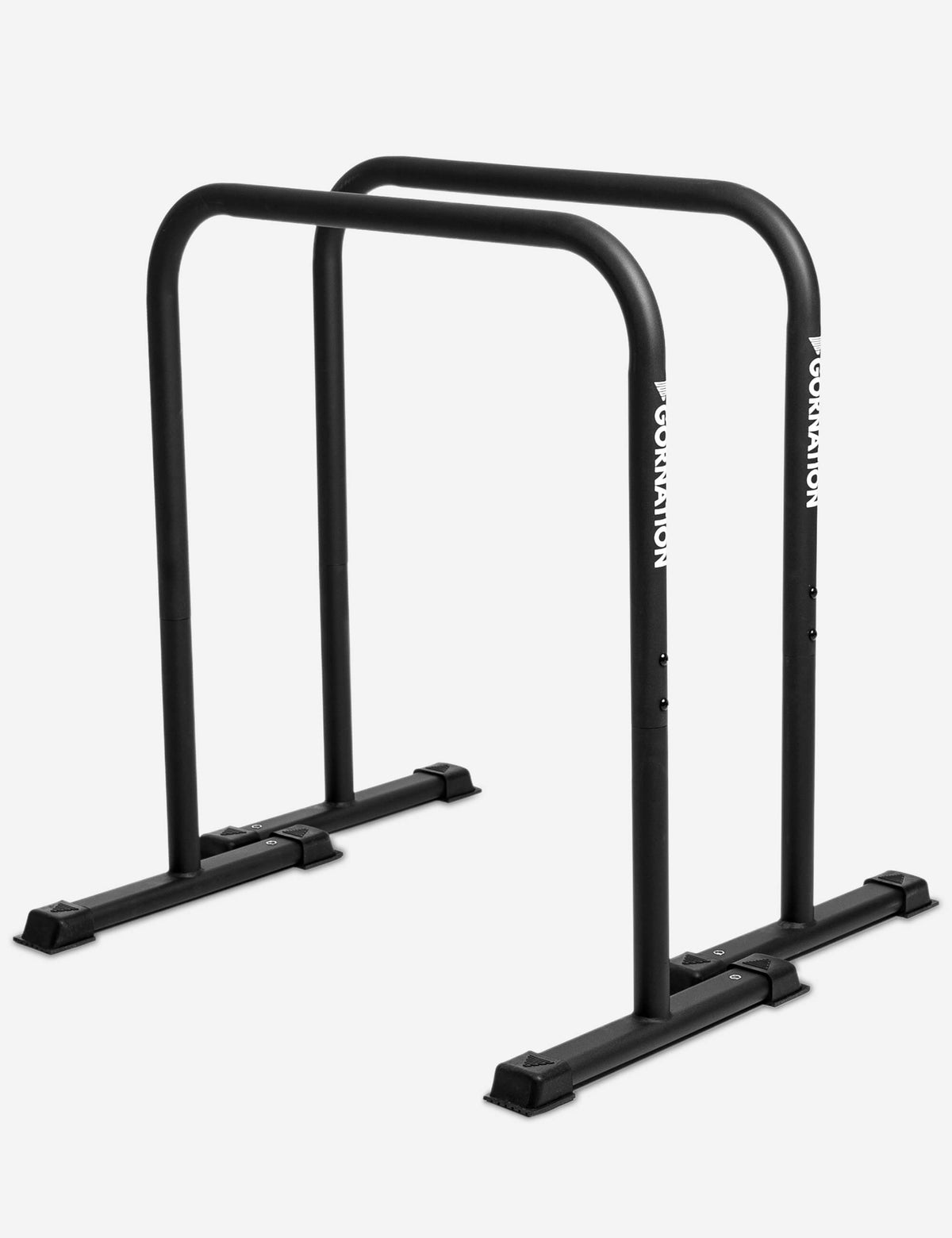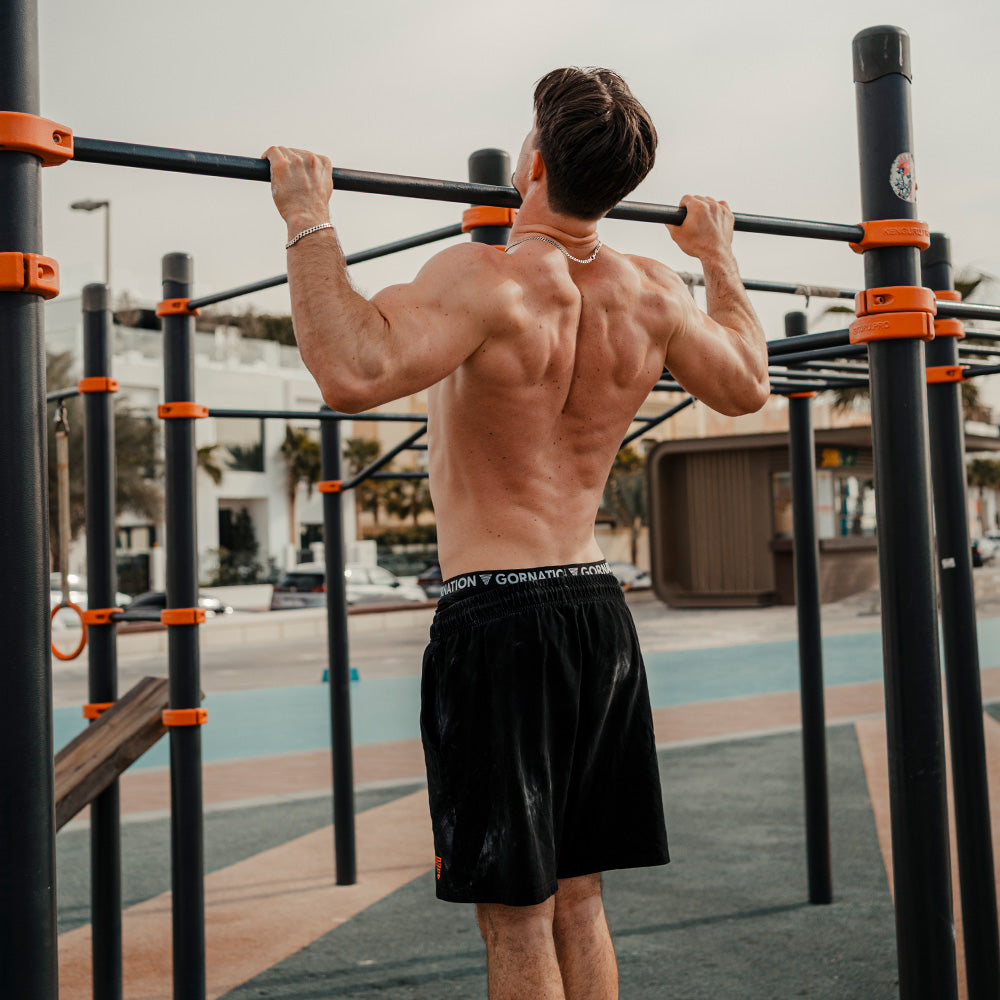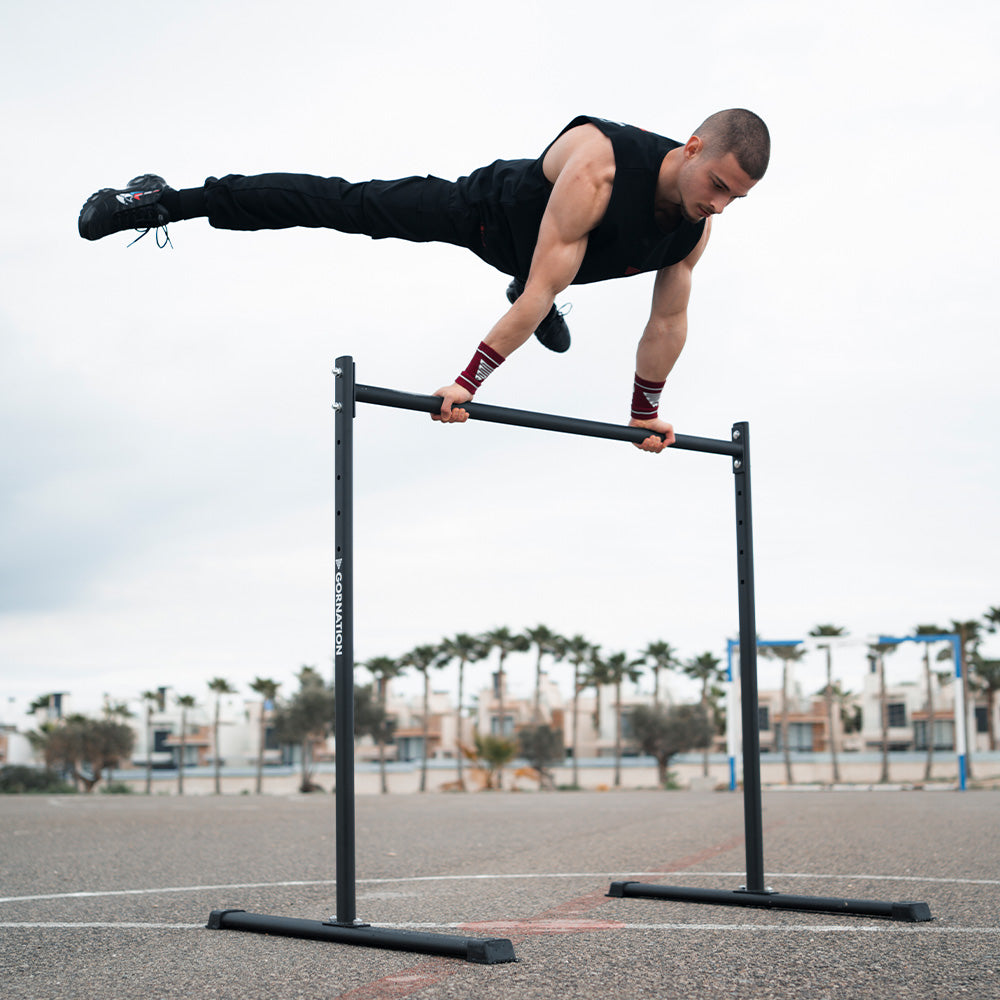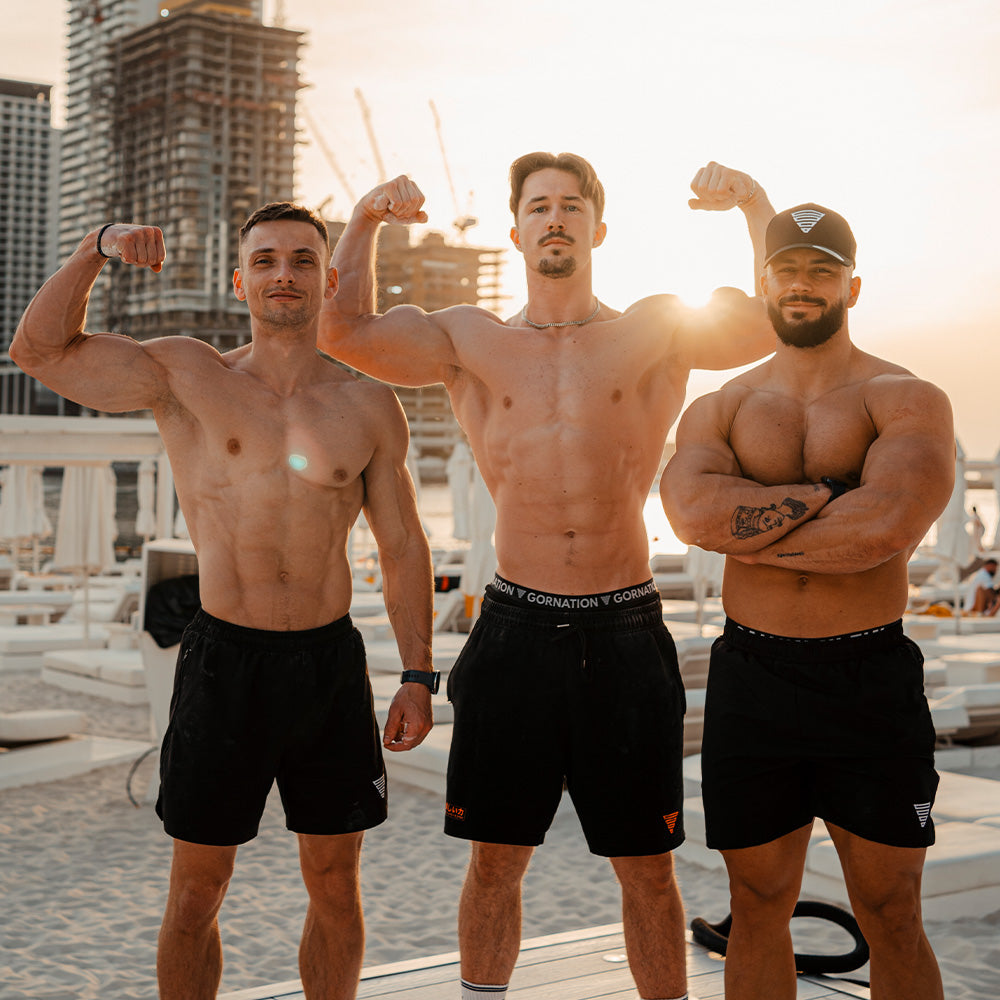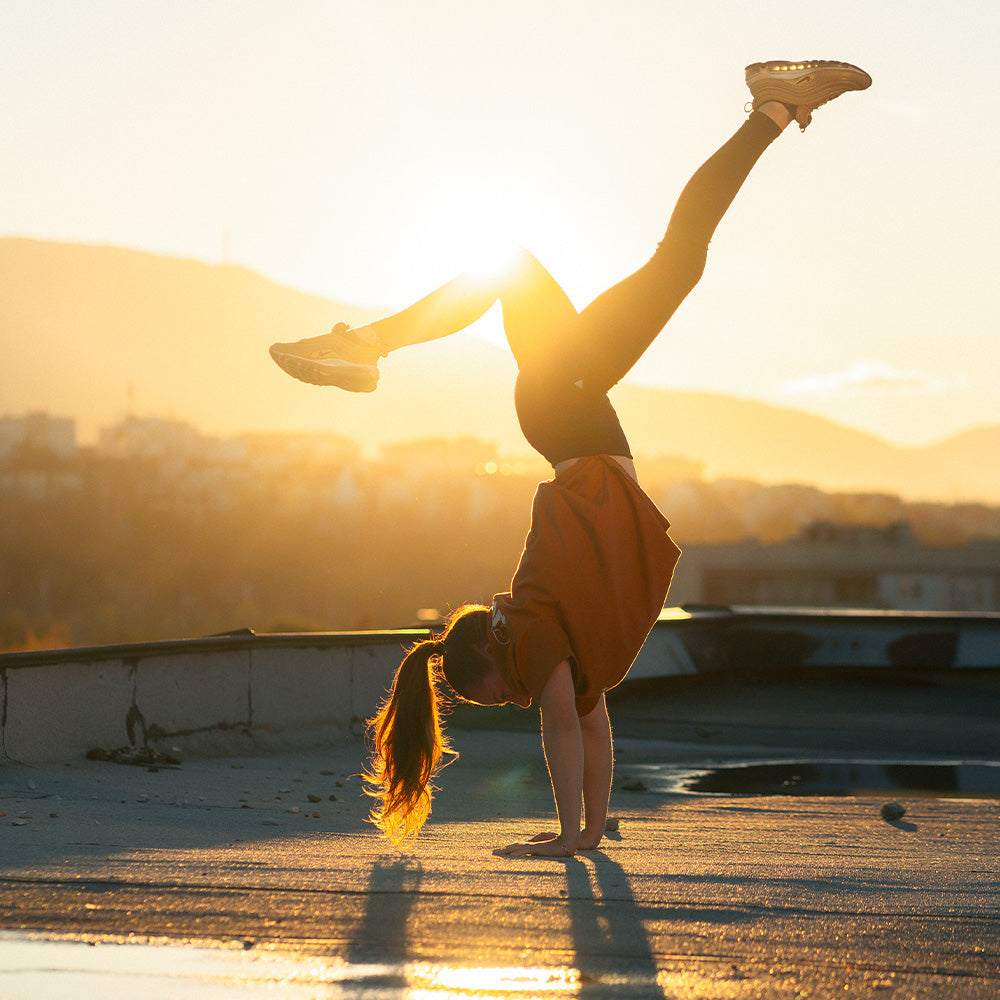ADVICE YOU NEVER HEARD OF BEFORE | Interview with Yaad Mohammad | Athlete Insider Podcast #70
View the interview here:
Or listen to the interview here:
The text of the interview (translated automatically):
gravity works like this your elbows are being pulled down they want to actually overextend and break but what your bicep does is like nah i do this that's why gymnasts have huge biceps dudeyo gorillas welcome to the athlete insider podcast by GORNATION my name is phil and today's guest is the statics beast from the netherlands the medical student yad mohammad i'm really looking forward to this interview about calisthenics programming so yeah welcome to the show thank you for having me super awesome to be here huge fan of granation and uh super stoked to do this interview thank you thank you that's uh awesome words already that makes me happy so today the focus should be really about your questions on uh that you post on on instagram we received a lot of questions about calisthenics programming you're somebody with an a lot of a lot of knowledge and a lot of uh like interesting insights into the sport and yeah i'm looking forward to and super thankful that you share this with us todayof course anytime i'm very curious to the questions awesome so yeah before we start with the content maybe you want to share a little bit about your background who are you where do you have all the the knowledge about calisthenics and what do you dookay so let me make that long story short i've been doing calisthenics for almost 11 years the reason why i studied medicine was because of calisthenics i was super obsessed like most of you listeners probably are and i eventually wanted to learn even more so i decided to become a doctor and in a few months that quest is finally done so in october i'll finally be a full-fledged medical doctor and in this six years of studying i've primarily looked at calisthenics from a scientific point so i looked at the biomechanics you know at the anatomy of the muscles but i've also looked at the sports science which is a big field so something that we're going to talk about today programming periodization recovery fatigue and that's something i've thrown myself into and uh now that i'm finishing this uh medicine uh study hopefully i can eventually specialize in sports medicine with a super specialization in calisthenics and gymnastics and strength sports in general so that's something i i hope that i can help the world with because i feel like there's a lot of questions that can be answered easily but there's no one that actually addresses them in a organized manner so i hope i can help people with that because i've made a lot of mistakes in these 11 years trust me and um i've developed myself to uh i'm proud of myself as a calisthenics athlete for what i've achieved in this training career wow super cool and this is why i'm really looking forward to this um so you already said like 11 years of calisthenics which is a super long time um can you share us a little bit um how was your journey how did it go like uh maybe already show some small mistakes that you did along the way why uh why you could could be like uh in a like in an even more progress version of yourself if you would have like known what you know today yeah so uh something um the reason why i started calisthenics was because of the planche and i feel like a lot of people are super obsessed with the planche and i was the same and i when i started off it took me six years before i got the full planche and that was because i was just not i didn't know what the hell was doing and i wasn't super gifted when it came to the planche on the other side i had the front lever which is something i didn't even care about and it took me like a year to get it so you can clearly see there is a this balance in the thing i was interested in and i think i was actually good at so in this career the first few years i was super obsessed with the full planche didn't get it i got to the fellow pledge fairly quick so two years and the full from lever i got like after a year and then uh eventually i got injured multiple times my wrists my elbows got overworked shoulder injuries and so quick quick reason why that was is because i didn't know what i was doing i didn't know how recovery worked and as i reached the six years i finally got my full planche and i immediately lost it because i started spamming it because you see on youtube all these planche athletes doing it constantly but that's not realistic so that's one of the things i eventually learned and then i got it back again and then i got like a bunch of other injuries and all of that can be related to uh knowing the capacity of your body you know your body has a finite amount of recovery and you need to know that recovery rate and once you know that there's a lot to gain so right now the things i'm proud of the milestones i've reached uh i can do a fairly good victorian on the ring so i'm super proud of that i've done a 50 second full front lever so i'm also super proud of that uh when it comes to planche i only got 10 seconds i say only but if you compare it to the full front lever which is really up there the full planche is not that impressive as if you're related to i'm not saying full pledge isn't impressive but if you're related to the full front lever it's not that great and then when i pull ups i got like 10 one on pull-ups which is something i didn't primarily focus on so if i wanted to increase that i can also give tips in this podcast on how to actually improve something like that and i think those are the things that that really stand out uh when you look at me if you look at me as a gastance athlete i'm more of a static one and uh i'm a pool athlete who is obsessed with push but gifted the pool so that's a basic uh journey of my basic summer of my journey as a gastonix athlete nice so like jumping into this thing because uh people usually in this podcast listen uh who listen to this podcast are uh they hear like one athlete says yeah like i'm a pool athlete like the other says no i'm more push athlete what does it mean to be a pull or push athlete what what's the thing what's the meaning behind itso the meaning is um this is quite difficult question if you look at the best planters and you mean you look at the best full front lever people and there's a friend of us of you me frank's is actually doing a study on this we notice that some people are just inherently better at doing pull movements people who are quicker at achieving the full front lever people who are quicker at doing one on pull-ups these people just seem to be more natural at that and on the other hand you have people who are pushers who have a very hard time doing pull movements but then on the other side they're great at pushing they're doing handsome push-ups as if if it's nothing full planches come in very easy and of course there's something in between the mix type these are people who are like right in the middle they can be either great in both or bad at both um and the reason for that is probably because of uh genetic variation which could be muscle insertions it can be the size the length of your of your limbs it can also be how the joints connect for example if we look at something that's very well studied power lifters we can see that asian power lifters have a very different type of hip joint compared to people from africa uh it's it's just it's night and day it's as if it's not the same hip uh the same can be true for of course calisthenics athletes and that's what we mean someone who is more genetically gifted towards the pool and there's people who almost more who are more generically gifted towards push and then there's the in-between so that's kind of what i mean when i say you're more of a pusher you're more of a pulling yeah and you already like teasered it a little bit we're part of a project with our uh like friends uh friends eric from frink's movement to like bring some clarity and some data into this topic so i'm also really looking forward to the results of this um yeah so um maybe you can share a little bit how was your journey as a as a pool person who fell in love with the push movements um how did you handle this um how did you like uh how did it influence you in your in your workouts so uh i was doing calisthenics primarily just for fun i was just obsessed with the full planche and then i think it was around the fifth or sixth year that i woke up in the morning and i did a full front lever max hold because i was just curious i was like hey how long can i hold this for at the time the world record was held by alexa steele who had like a 53 second i think and i woke up in this morning totally not warmed up all my rings in my bedroom back then i think i was in 1920 or something i did a full from lever and i had 43 seconds a movement that i had not pursued a movement that i didn't even maintenance that hard it was just something i would do every now and then at that moment i realized i was gifted at that moment i realized maybe i should take calisthenics even more serious i was training really hard but at this point i made a switch in my mind i was like yo i'm actually really good at this i'm very gifted i should be doing something with this and besides i'm obsessed with it anyway so that was the turning point for me i think around the 56th year when i said this is serious now this is this is my life this makes me happy and i'm actually good at it and i think i know enough to help people with and i think i'm able to teach people this and improve the field so that's kind of the journey what what it meant for me to be a puller so even though i didn't fall in love with pool which i i love it now but back then i didn't realize that moment when i did that full front lever in the morning changed the way i thought about calisthenics and what it meant for me as an athlete but also as a doctor true super interesting and um how like what what mistakes do you see nowadays like when you and during these 11 days uh 11 days 11 years that you're doing calisthenics what mistakes do you see people doing in their like playing of the workouts planning of their weeks planning schedules uh yeahso something that i uh often see is that people are overestimate how much they can recover the thing is for example people who practice statics for example have a lot of straight arm movements and a lot of people don't realize that for example when you're doing a planche maltese iron cross there's a lot of passive tissue in your elbows that needs time to recover i'm talking about ligaments but also about tendons and something that i think a lot of people don't consciously think about is that there's a limited capacity muscle tissue recovers fairly fast because there's a lot of blood that goes towards those tissues but uh ligaments or just connective tissue so also tendons there's a lot less of that going on meaning it takes a lot more time for those tissues to adapt and you need adaptation so that it becomes stronger adaptation basically means that the tissue adapts to the stress that you're putting on it so what a lot of athletes do is they suddenly start doing more of something so one week they're doing only one planche and then suddenly they start doing it four or five times a week and what that does is you're adding so much stress your connective tissue is like okay cool i'm going to adapt to this but then you're doing it again and in the next week and then again in the next week and it needs six weeks a minimal and that's based on studies it's like six twelve weeks and if you're not giving it that time you're only damaging it so you're damaging it it doesn't get the recovery you're damaging it even more it doesn't get to recover any damage even more it doesn't get to recover at a certain point it just breaks it doesn't like tear sometimes it tears we see some biceps tendon tears and stuff and then you're basically destroying that that tendon and i'm not saying people uh you know be afraid i'm just saying be aware that when you're increasing volume so now we're talking concretely about volume when we increase volume be aware of what you're actually taxing in your body if you're doing straight arm movements don't just go out don't do a lot of adding volume out of nowhere also when it comes to punch push-ups for example you're in a very lean position and then for the audio people what i'm doing right now i'm in a planche lean sort of and then i'm pushing out that's a lot of tension on your elbow flexors and those elbow flexors you're repeatedly like putting tension tension tension which is fine if you're not doing too much of it out of nowhere so for the people who do want to like still practice full planche push-ups or straddle punch push-ups or talk plenty push-ups or events like quick shots whatever but they don't want to like over uh over do their elbow flexors they can do like near lockouts so some people are going to hate me for this but i'm just saying don't lock out you know just do a few reps like that and for you know once a week maybe do lockout so you also practice that and then after a while after six weeks do it twice a week and not of course there's a cap at the bot at the top but the point that i'm trying to make is be aware that connective tissue takes a longer time to actually recover and be mindful of that don't just add volume to it like you have this new movement don't just spam it don't do that it's it's the recipe for getting injured and one more thing which is more general for every sport once you've rested or you haven't done a movement for a while don't immediately go back to the old level so let's say i took a deal out week it doesn't mean i can do everything i did the week before i need to build up again respect that respect the volume you've done you can't just go in like that and if you got injured and you're now like oh i feel good don't go full take your time build up again because again all those tissues need time to adapt to the level that you've built up build it up to so that those are the two main things i see calisthenics athletes totally well not totally but they they're not consciously thinking about this and i think if they do a lot more injuries are like prevented by doing that wow that's uh like super valuable um and i it's definitely true i didn't know about like it's a super interesting thing about the not looking out um and i think that's like one difficulty i also see as an athlete is there are so many things that so many information pieces that are flying around and you need to assemble them and somehow put them into into one workout because you everybody's limited with their time even though even if you can take um three or four hours of your day and put it into workout and recovery and everything it's still difficult to assemble all the stuff that you hear about deload weeks and um rest and like um yeah a lot of volume a lot of like um intensity etc so how would you approach this whole topic of calisthenics programming and putting it all into one schedule that fits your goals that fits your lifestyle how would you approach it with the knowledge that you have today so there there's a a bunch of ways to actually approach calisthenics training and depending on your goals there's a bunch of things you can do there's no one-size-fits-all program but something that generally works is you have to be aware so first off you need to write down your goals you need to be like what movements do i want and you can't have every movement like all together at once you need to prioritize so look at the major movements now let's say you're static guy and i'm also a static guy and then let's look at our body we're like okay the elbows they have a certain capacity my shoulders have a certain capacity my wrists have a certain capacity you know let's look at all thatyou look at the prime movers and a lot of people have the full planche in mind that's the end goal a lot of people have to fall from lever in as the end goal and they probably have like handsome push-ups or one-on-pull-ups in there too or or iron cross etc make a decision choose like one push one pull that you're going to focus on don't do them all at once just take your time you know we're not rushing towards anywhere then once you've identified those muscles uh those uh those uh movements look at the muscles they're actually using so for example planche we know there's a huge delt component there's a huge chest component but also a lot of people don't know huge huge huge bicycle component of course also triceps but the biceps are completely neglected you're like why my arms are locked so shouldn't that be triceps well your elbows so for the people who are listening what i'm showing is that i'm blocking my elbows and so gravity works like this your elbows are being pulled down so your elbows have the they want to actually overextend and break but what your bicep does is like nah i do this and they do it isometrically so that's why gymnasts have huge biceps dude that's why because we we lock out our arms they lock out their arms and they're able to not break their arms because of those huge biceps so identify those muscles then train them you can train them first if you're if you're skinny dude you don't have a lot of muscle you need to make sure you have muscle before you work on the planche so you can just what do you do you can work on push-ups you can work on dips maybe if you are also a gym guy you can do some bench press also if you want to you don't have to but as long as those muscles grow and then you look at the elbows etc you grow all of them okay now we've got that component down next step and you can do this simultaneously now you need to learn how to planche so what do you do you have a skill work so what we talked about now is basic strength now we talk about skill work scale work is actually doing the movement you want for want to do it's the most specific movement to the end goal in this case for full planche that would be like a planche lean or maybe a planche with resistance bands so you practice that like one time a week in the beginning and you do like a lean you hold it for 10 seconds and you do that like two three times then the next like in four weeks you add another set in that entire week so now you have a second day where you're doing planche but you're not adding set you're adding day of blanching and then after another four weeks you're adding a third and i would stop at three four times three is like four is really pushing it so i would have three and now you have like a pretty nice program for planche and you need to do the same for for front lever and now you just already have a pretty general program it's a very basic program but it works and it works because it's a safe safe way of doing it and obviously in every strength port there's one principle in the middle called progressive overload progressive means just progressing and overload means adding more load so you need to make a movement always harder the the next time you do it so you can do that either by adding more reps or you can do it by adding more weight or by making the exercise harder so for example let's say i'm doing 8 to 12 reps for something i do like dips let's say i'm doing 50 kilo dips i get eight nine i get eight reps uh the first time and then at the second set i also get eight reps the next week i try to get like nine at least nine nine maybe i get ten ten maybe i get eleven even if i hit the twelve twelve i add some more weight so that's one way of approaching it there's hundreds of ways of approaching it this is a very basic way of approaching it if you choose the side of going fully calisthenics and you're not adding weight but you're making the exercise more difficult so this is just a step side step be aware by making a movement difficult so let's say you're doing from tuck planche you're going to advance talk be aware now you're adding more to this so you need to do that slowly so don't replace all your truck planches with event stock replace one set first after four four weeks or six weeks replace another set with event stock that's the safe way it's super conservative i am aware of that but it's the safe way of progressively overloading when you're making the exercises more difficult now it's very hard to answer this question in a very organized way because there's a lot that comes into it but i hope i can give like an idea of how you should be thinking of training it's really not difficult you have muscles they need to be bigger and once they're bigger you need to learn the movement that you're doing the hard part is knowing how much time in between and how you're going to do progressive overload and you can read all about progressive overload it's not a calisthenic-specific thing it's a strength specific thing and a lot of books cover this and a lot of youtube videos cover this type in progressive overload learn about it and you're probably gonna learn a lot just know that's in the center no progressive overload there's no improvement so i i know i'm talking a little bit from all sides but i hope to give like an idea of what you should should be thinking about when you're doing when you're setting up a program definitely i really like the idea of like having a certain capacity per joint uh and per uh like uh two two and this capacity you have to distribute on on your goals yeah and if you uh like select too many goals you have like you don't have enough capacity per per skill and per goal that you can uh uh yeah exactly ask the joint and i want to say one more thing when you're selecting your goals there are some movements you shouldn't select in my opinion back lever should never be a goal why back lever puts almost as much pressure on your elbows as a maltese so by doing back leaving your training you're already draining your elbows and you don't have any time to do anything else so you're already done and and back lever and you probably noticed too is something you get for free when you work on planche so just do your plans training and after a while you get a back lever for free without practicing it but if you practice specifically for it back lever doesn't really translate well to other movements and it drains your elbows so fast human flag is another one of those movements if it's your angle fine you can do it but if it's something if your goals are higher than that you'll get it for free don't worry about it don't waste your time on a movement like that you'll get it for free i i trust like believe me you will get it for free so movements like back lever and human flag i'm not a huge fan of because they don't serve a big purpose in the end goal if that's not your end goal you know you know what i mean that's that's that's why i always say look at the capacity back lever just destroys your elbows there's no need to do it it doesn't destroy i don't want to be negative about it but i'm just saying it takes up so much capacity of your elbow do you really want to spend like so much money on that elbow by doing the back layer i wouldn't personally want to do that yeah but it's it's the same as in in life in general you have to decide for a few things like we as a company we have the motto for for ourselves we can do anything we want but we can't do everything we want and it's like um perfect um because you only have this limited time per day and you only have like a limited time you can spend a week and stuff like that and you just have to spend it wisely and it's the same for as you say for joint capacity and that's super super interesting and maybe also eye-opening for a lot of people because there are so many like and this is the beauty about our sport that you have like uh 20 different push movements that you could learn uh 30 different pull movements and like there are so many things it's like a video game where you don't know where to run in which direction but you have to decide exactlyyeah you have to decide yeah um how do i deal with and this is something i just realized when you talked about progressive overload how do i deal with a bad day and maybe even a bad week like um having like uh slept didn't sleep well or at work we i have to work a lot and i don't feel good at after work how do i manage mentally and physically uh a day where i can't go up like and i should go up with progressive overload do i still go up and just maybe you can that's a great question so if it happens once in a week don't worry about it just try your best and if you don't finish it it's okay like don't be mad at yourself if it happens the second time you should be asking yourself a question am i over training am i like doing too much right now did i sleep enough did i eat enough is there something wrong in my training because chances are if you if you have it twice in a week and even a third is like a definite then that's like done that's there's something wrong um you need to address that so it could be that you're over training now and now it's time to do a deal out and that's okay note that down write down for yourself after how many weeks did i get tired that's valuable information because next time you set up your program you can look at that if it's like after six seven weeks that's pretty good you know you can be like oh that's nice but if it happens after two weeks you're doing something wrong your progressive overloads may be too fast or maybe you're not sleeping enough so note that down note the reason down analyze it look at yourself be your own coach you know or discuss it with your coach look at the reasons be like yeah you're right you know what i only slept five hours a week of course i'm not gonna make any progress and that's another thing a lot of people sorry for another side step a lot of people work so much on uh recovery in the sense of like saunas massages etc uh doesn't matter if you're not sleeping enough you can do everything everything you want does not even matter like it's it's only like five percent what you're trying to do so if you're an elite elite athlete it matters but the sleep that's the most important because that's 50 or more i'm just throwing percentages i don't have data for this but it's so ridiculously important sleep there's i always say this there are three pillars a lot in the training that's important you need to have good programming if you don't have good programming then you it doesn't matter and you need to have good nutrition so you need to be eating enough or deficit if that's what you're planning for either way it needs to be good and three you need to be sleeping enough slash resting enough if one of these pillars falls you're not gonna make progress treat every pillar as as equal as the other so you can't just be like all focused on amazing programming if your sleep is bad doesn't matter you can be focused on sleep only if you're not training doesn't matter you can't be sleeping and training perfectly if you're not eating enough it doesn't matter all these three things need to be checked before you can make your next step nothing else matters saunas doesn't matter ice bath doesn't matter it doesn't matter that you're improving your programming as long as all these three things aren't checked so i see a lot of athletes there they're like in the weekends they start drinking alcohol and everything which is fine you don't like i'm not saying don't do that but be aware that you need to be sleeping enough you need to be getting enough food you need to be and you need to be training properly those three pillars one of them falls your whole foundation is off oh and and that's the reason why i brought that up is because if you're having multiple bad days then there's something wrong with those one of those three pillars so that's what you should be doing once that happens analyze it look at it why interesting how do i um manage to put like front lever and planche because these are the two most common skills that people ask for how do i combine these two into a one workout program like into one week um can you tell us more about like even if you like when you picked uh your three exercise one push one pull i don't know what the third was um but if you decide for these like how do i combine these into one weekso the beauty about planned gym von leaver is they're sort of like opposites um meaning you can even superset them so you can practice them within the same day but if you want you can split them you can have a full front lever day and you can have a full plunge day so that's the beauty about it what you should be thinking of is first you need to know do i have again like i said do i have enough muscles because if you don't you need to be working on the basic strength so you need to have a pull day you need to have a push day or you can combine them because again they're they're opposites so you can actually do them at the same time something i do now myself which isn't scientifically the most efficient way of training but the reason why i do it is because i was injured and i'm recovering so everything works then so i might as well do something that's fun is i do three full body basic strength days on the on the tuesday i do a 2 8 to 12 rep range day where i do horizontal push so that can be bench press push-ups or planche push-ups something that's as long as horse on the push i have a vertical push movement that can be overpressed handsome push-ups or anything that's overhead i have a vertical pull that can be one on pull-ups weighted pull-ups or just normal pull-ups and or lat pull-downs and i have a horizontal pull which is like rows whether that's from lever row or cable row anything and i hit those four and i do that on the tuesday for 8-12 reps on the wednesday i do or thursday depends on how days go i do 20 to 25 reps and on a friday or saturday i do two to five reps and the reason why i do that is one for fun it's just really fun of training it works and um and then in between these days i have skill days where i practice from the full front lever i look at my form i try and max hold i do victorians i try to fix my false grip maybe reduce false grip i look at my planche again film it make sure my hips are straight if they're not straight like why is that happening try to improve it try to do presses and that's what i'm doing in between these days so for me right now the main goal is getting my muscles back but at the same time also reintroducing these movements what i'm going to do afterwards is i'm going to kick off one of these strength days probably going to be the 8 to 12 day and i'm going to add another one of those skill days that's how i do it again 100 ways of doing it this is not the most efficient way that i'm doing it i used to do it more efficiently but this is one of the ways and for most people who are listening to this you're not a world champion or anything like there's only a few whole champions so don't worry we're talk all these little details that we're talking about are slightly better than the other we're talking about maybe two or three percent which for you as an athlete isn't huge but for the world champs of course is huge for so for the majority of the people listening all these other details don't really matter you can you can't screw this up so full front lever and full planche can be easily combined in a program it's actually beautiful to do that but when you have multiple pushes that's when you need to be thinking hey i have multiple pushes that i'm pushing for when i planche when i do planche training i always have over a press because you need to make sure that you're balanced in all that's why i said horizontal push holes on the pool house vertical push vertical pull always make sure you cover all of them but the focus is on one of them like more one of them so i hope i answered that question definitely are these days no worries are these days where you do the skills are these also like fully structured because you said that you play a little with your full script and stuff like that uh these days um like structure do we have like i have to do 10 sets of front lever 80 hold or like are these more for fun and you just listen to your body so i used to do extremely structured and i recommend everyone to do that if you haven't been training for five plus years um so i used to be like very rigorous i would be like okay i need to do a planche progression that i can hold for at least six seconds but max 10 seconds and i do two sets this week in two weeks i'm going to do it in four weeks i do a third set and i only go max four sets in total that's how i used to do it um and i would note down everything and i would write down i would look at the previous week and if i would see with declining like hey why is it declining i would look at the pillars and et cetera et cetera right now because i'm training for 11 years i know my body really well so i know what my capacity is and you'll notice that people have been training for very long can't do this but again beginners cannot do this even if you can already fool maltese you're one of those freaks that has been able to do that within a few years you don't know your body as well it's because you don't you didn't have the experience it's impossible to learn your body to know how your body works like that so it's nothing to be ashamed of it's something you just learn when time comes so for everyone listening probably is i would recommend note down and like i said bear in mind there's progressive overload when something is locked be aware of how much adaptation there can be and just try to progressively overload try to hold it longer and longer once you've had hit the 10 seconds for example add a harder progression if you can't try to find a mid progression build it up again and just etc etc etc that's one way of approaching it when you start with your exercises like um of course you have the priorities uh of the of your goals so for example for you like front levers more important than planche um or other way around but with what exercise especially when you talked about super sets um with what exercise do you start like um as an example i can do the one i pull up with my right side but on the left side i'm stuck at like something around 75 and i can't get my chin over the bar but for me my goal is to be balanced to not create any disbalances to fix stuff like that so do i start with the left side um or do as do i like do the right side first so i don't have any uh like data on this this is just me doing what i do and i'm also very ocd for keeping things very uh symmetrical start with the weak side then match with the strong side so that's that's a simple way of doing unilateral things when it comes to prioritization of like which movements you're interested in start with the movement you're most interested in and then at the end of the workout do the ones that you're you know a little bit less interested in there is a uh there is though i don't do this i'm more interested in planche but i still start with pull ups first why because i noticed that when i do pull ups first my shoulders are better warmed up and my push movements do better so there are some re some exceptions to this rule but generally you want to be moving starting with the thing you're actually most interested in but again if if bulls feel better in the beginning just do pulls first you know it's it's it's and and again these differences don't matter that much in the grand scheme of things uh at the end if you're still doing progressive overload once you've completely rested so you've had a de-load you will still be very strong when you're rested so like um what i mean with that sentence is even though you are always weaker because you're doing these movements later on in your training once you're rested you've still added the same amount of stimuli every week and every week in this weaker state so eventually even though it's a little bit less efficient you will still have very good results when you're completely peaked out ready for a competition okay so for a uni so sequels doesn't matter okay okay that's that's good to know uh for unilateral skills or moves like like the one on pull up or also like human flag um when i have like one weaker side and i want to uh create the balance and i don't manage to do the move and the skill 100 with the weaker side is it more intelligent and more smart to do for example the left side with a resistance band and the right side like without or like how do i fix these disbalances because i see a lot of athletes who also fee feel like um the the results of like not being balanced in the straddle planche which is like um tending to to go to one side and stuff like that so um how do i fix um fix these uh disbalances so first of all be aware that the asymmetry is very normal and there's a chance that it will forever be there actually it will always probably be forever there so you can't completely fix it and i wouldn't over having that bearing that in mind i would just not make it too complicated just try to do the weak side first and always match with the strong side so your strong side is going to be under stimulated most of the time eventually that will be brought a little bit more in the middle but there's a huge chance and it's very likely that the strong side will always be the strong side and that's okay there's nothing wrong with that there's a reason why we have a strong side that's just how our bodies work we are not symmetrical being symmetrical beings we we like to be but we're not and that's okay for movements like flange which is a very which is like a bilateral movement just look film yourself try to make corrections and if it doesn't hurt and if it's like acceptable like within within like uh the margin of error don't don't like overanalyze don't get uh over obsessed if it doesn't cause any problems and only you notice it maybe it's not that important okay just enjoy your plan you know be happy that you can pledge nice okay cool so in the beginning um switching topics now you talked about uh you said that most people don't know how recovery works um so my question now is how does recovery work what uh what's your uh what's your advice on thatso in a nutshell what happens this is very very uh simplified uh let's take the muscle tissue for example you do a movement that's stimulus stimulus causes like microfiber uh micro um micro tears in in the fibers and so what your body thinks is hey we need to repair that and there's probably going to be more of that more of that coming sooner so you recover so stimulus now you recover you rest your rest takes a few days your body adapts that's the third step adaptation your body fixes those micro uh fibers and even makes them stronger than before so now you have those tears they're they're improved they're even stronger and they're ready for the next one what do you do you're like okay whatever i'm gonna add more weight another tear your body is thinking okay [ __ ] another tear repeat the process you rest you adapt when does it go wrong is when you start doing the stimulus again before the adaptation happens so here's the here's the i'm not gonna because there are audio listens so you have to stimulus again uh the tear is there and now you're doing the stimulus again you didn't recover yet so now the tear is even deeper your body's like hey hey calm down come down and now you're doing it again so the tear is even deeper and now a micro tear starts actually having effect on how the muscles work now you're injuring your body muscles have a very short curve stimulus recovery adaptation curve we call that in this in sports uh principle so this is actually aa term that's used in sports science when we describe how adaptation works when stimulus recovers adaptation and that curve for connective tissue is much longer that's why i mentioned the six weeks it's not exact but for for a connective tissue it takes six weeks and so what prioritization like critization is a method of um having periods of different kind of training what smart people do when they do periodization is they look at the curve and they try to plan around it six weeks i'm not saying do a plan should i wait six weeks and do it again you're gonna do stimulus again when the recovery happens there's that's just how life works and you're gonna keep doing it so the curve goes down down down down at some point you need to be like now i'm gonna do deload so the curve can come all the way back up now it's recovered and you can start over again so that that's an important thing when you have the stimulus recovery adaptation thing it's important that you don't do too much stimulus but also not too little stimulus so you're always going down with the curve when you're doing training so you're always not recovering slightly just enough and after six to 12 weeks or something it really depends on the type trading you need to do deload once you've done the deload now you're fully recovered and now you can start the process over again people who don't do the deload and will keep pushing and pushing pushing keep going down down down down down they never get enough recovery they get injured so that's kind of how recovery works so it's again just just to make this a very disorganized story organized you have stimulus which is the training you have the recovery which is the resting time you have adaptation which is improving whatever that was stimulated and as you train it goes you get more damage than damage and after a while you need to take a week like a week break and then you come back again and if you train biceps every freaking day that's way too short within a week you will tear your biceps well not probably not terrible you will have so much pain that you didn't recover enough and if you do too much of it like within weeks like three three three three which out of nowhere again you go down so fast you're doing probably too fast of everything so you need to be rethinking look at the pillars etc etc so that's kind of how recovery works in a very nutshell it's that curve and if you can you can look this up if people are interested look up stimulus recovery adaptation curves sra curves just look that up it's it's a very well described principle uh mike isatel has it also in his book who is uh who has a phd in in sports science and he also describes this for power lifting but power lifting is also strength sport and so is calisthenics it's not that different the only difference is exercise selection wow super cool um super interesting and i really feel this is the bottleneck for a lot of athletes out there like um they want to um invest time and like energy into the sport and into their professional like into their sports career but like being disorganized and not having this this information it can easily like lead to injuries and to um yeah to not an effective investment into your your sports career so super super interesting really um something that goes along maybe with this topic and i was also like um a frequent question when we did the instagram survey before before this interview was um muscle inflammation so we also had like an elite athlete um asking uh you in in the in the instagram poll um what how do i in uh like avoid and also cure afterwards like muscle inflammations um yeahmuscle inflammation has a very negative tone towards it and it's actually very positive thing without inflammation we can't improve that record that adaptation part is actually uh done by your immune immune system that that's actually the system that makes sure there is adaptation there there's been multiple studies on people taking ibuprofen which is a non-steroid anti-inflammatory drugs these people who take that chronically and i think it was above 200 milligrams you need to have at least that until you see this effect that i'm going to describe is they don't have any muscle growth when they're training or at least it decreases by a lot so people chronically take anti-inflammatory stuff have a lot less progression so when i think of muscle inflammation it sounds very negative but it's actually essential to training i'm i i don't know what uh what he means with muscle inflammation but i think what he means is that he's just not recovering enough and that's the pain the delayed onset muscle soreness which is a sign that you just haven't recovered enough but muscle inflammation is essential for adaptation and a lot of people don't know that it's very essential so don't try to take a for example ice baths is something that's also done frequently but we say to see the exact same thing when you do ice baths there's less adaptation it's actually not a good idea to do to do ice paths if you're trying to improve ice pats are great though for if you're doing competition after competition after competition when you're doing a competition routine you're not doing that routine so that you become stronger the next time you're doing the chill off you know that's the purpose so then it's okay to do a nice bath so that you can do it again the next time so you don't get injured but it's not a good idea to do it regularly after a workout because it's going to prevent you from actually adapting the whole adaptation that you're working so hard for it's not happening anymore so i hope that kind of answers what i think about when someone says muscle information definitely so stuff you can do about it stuff that still brings uh like progress would be nutrition i think this is something how you can uh like uh yeah so that so yeah so how can you improve recovery because that's the actual question so how can proof recovery it's the three pillars nutrition get enough nutrition in which means getting enough protein in getting enough calories in if you're cutting be aware that also means your recovery is less good so when you're cutting change your program you're you're now recovering less be aware if you're not then that's fine you know but nutrition needs to be good you need to be sleeping enough sleep also make sure that you're doing adapting faster because that's what's happening so you're recovering faster and good programming so making sure it's paced out perfectly or not perfectly good enough so that it's not like you're doing it five times a week bicep curls like that's how you can improve muscle inflammation but again muscle inflammation is a good thing we need that you need to recover your recovery so you can do it faster nice and that's the that's how you can do it awesome well like i learned so much in this uh this interview like in this podcast uh thanks a lot for sharing so so openly and so honestly so um yeah i still prepared some some quick questions um for the end of the interview um it's not that quick questions quick answers like we usually do but i thought like of some some questions that i think are super interesting because they are questions who are like us really frequently maybe you say it's a it's a stupid question um there are no stupid questions but there are like questions who uh who have to who could have asked like differently anyways i will just ask them um hey what's the best exercise for plancheso that's a question i often geti mentioned earlier in this in this podcast that there's multiple factors when it comes to planche there is the basic strength aspect which is purely made to increase the muscle mass and then there's the aspect of actually learning the movement so there so the inherently i can't say there's one exerciseand then there's the individual aspect so for some people bench press is excellent for for planche some people it sucks it's the worst exercise for planche so to answer this question you need to find out for yourself what the best thing is for the skill part i can give a good recommendation though for the skill part you want to do something that's as close to the end goal as possible so when you're doing full planche you should be thinking of a full planche lean but also you need to add a movement that actually requires balancing so maybe like attack planche event stock or shuttle planche something that requires balancing flange lean isn't the end-all be-all it's a great exercise because it's the same lean angle or at least it's getting close and then you need the other one to actually learn the balancing and then of course you need to work on the presses because that really helps and you need to work on the pushes then the push-ups so it's no exit one exercise it's multiple exercises so look at your basic strength which is a very dumb movement can be bench press can be push-ups something like that or dips and then look at the scale once which is like something like planche lean but also an open movement a balancing one and some presses and some uh push-ups cool um so no one next yeah true maybe we can still like um answer this for front lever um same same things like um one strength exercise which can be uh what cannot beyeah you can do rows so you can do like cable rows or if you're casting exactly you can do body rows and if that's too easy you do it with weight and if you don't want to do weight you can start doing advanced stock rows or talk talk from level rows so that's a good way of doing the basic strength and then for the specific one if you want to be specific you want to be doing like advanced tuck front lever and there's also like a planche lean equal from lever you can put your legs against the uh like a like a bar or something get into the position and slowly get your feet off also it's like a plane just lean same principle uh and then you have like umof course the open movement just like so you have to planche lean sort of but that fall from leveling and then you have like the tuck front lever advanced stock and then you have the full front lever pull and then of course the full front lever pull like rome which can be done again in tuck as van stuck which again can also be used as basic strength but it can also use be used as like a skill specific one so sometimes there's overlap it's not black and white okay but those are the exercises that i think of when when teaching some from someone i don't know what i'm going to do it looks intelligent here damn this looks looks so smart yeah like you could have you could have taken it like okaywhat's the most useful calcinex equipment that you know and that you use for for your own progress and for your clients progressuhmaybe if i can rephrase the question uh if there's only one equipment i can bring with me to ireland it will be rings because it's the minimal thing you can do pull-ups you can do dips to it you can you can do every exercise you can imagine it can all all be done on rings so rings okay cool um what's the best warm-up advice that you havefor warm-up uh it's very highly individualistic and also time specific when i say time specific i mean are you injured now are you not injured are you feeling fine are they nothing for me some days i do like a lot of shoulder rolls etc some days i literally just sit down i breathe in and out and i visualize the movements and suddenly i'm warmed up it's super weird like i can't describe it to people i just sit down and i look at the movement i'm like yep ready and i can just start doing my stuff that's that's sometimes how it works it's very highly individualistic you just need to make sure that this there's a few things important about warm-up it shouldn't fatigue you too much and it should just get you make you feel good so that you can do the movement that's the two things it needs to be able to do if you're doing freaking 100 push-ups etc that's too fatiguing and if you're doing something that doesn't even make you feel better at the end then do something else okay so yeah that's that's the two things they need to suffice with the same question for mobility like uh how important and what's your best advice about mobilityhow important is mobility is a good question uh you need to have enough mobility so that you can do the movements you want to do you don't need a split for a planche you don't need a front split foot planche you don't even need to be able to touch your toes for your planche so if your goal is planche then there's no mobility required maybe wrist mobility but then again you can do some p-bar planches and then you can reduce the wrist mobility so look at your movement look at what you need if you're doing a lot of handstands you know just try to improve your overhead like your shoulder uh flexion and if you're doing like for um movements such as yeah like i said planche working your wrist etc so and if you do mana of course then that's a whole different question you know then there's a lot of mobility you need to take in but is mobility required there's no evidence to suggest that mobility actually reduces the chance of getting injured i think as of now uh that last time i talked about this like was three years ago i think back then there was no evidence maybe something changed but there's no real evidence showing that you actually reduce the amount of injuries there is of course some syndromes or some cases where a muscle should be more stretched so that the balance of that joint is better but mobility inherently as a as like a very uh isolated thing doesn't necessarily improve recovery or reduce injuries that much okay so only do it if you need it okay nice awesome um last question of the day uh what's your general advice to the listeners so what's something that you want to give to to um to the community what's something that you think everybody should know and be aware ofuh be aware that calisthenics is both complicated and easy and when we look at a lot of these elite athletes be aware that you're not them okay so i can give you my front lever program that i did back then and i guarantee you ninety percent of you guys won't get a full front lever because of that and the problem with a lot of elite athletes that make programs is they teach you how they learned it and the reason why they're elite is because they're genetic freaks i am a genetic freak i admit this for full front lever i am a genetic freak does that mean i can teach you food for later yeah because i i acknowledged it i i don't give you the same method that i would give to myself um so be aware who you're talking to there's no one-size-fits-all and what victor kaminov does and and i know that he actually teaches people not the way he does it but he teaches like in a smart way but what he did for his own training doesn't mean it works for you okay what i did for friend liver doesn't mean it works for you everyone is individualistic just hold these principles that we talked about today uh maybe try to keep those central and i get there's a lot more that we could talk about but it's it's not that serious it's like it's it's not that complicated um all these improvements that we can talk about for hours and hours like you already covered 90 of you did if you do what we talked about today if you want that 10 because you're a world champion then okay then yeah then it is serious but chances are you're not that level and that's okay so it's not that complicated for most people that basically awesome thanks a lot for sharing really i really appreciate it i really appreciate your your approach to the sport and like talking about studies and really the scientific way um and also like looking for symmetries and stuff that you can learn from powerlifting and from gymnastics and other sports so uh yeah big big thank you for your time yad i really uh deeply appreciate it and i think people appreciate it a lot also especially those who stayed with us for such a long time in in the interview um so yeah before uh we end the episode um how can people get in touch with you how can they continue learning from you do you offer any coaching is there anything you can offer to to the peoplei don't do any coaching now because i'm just way too busy you can follow me on my instagram which is yada's week for now it'll hopefully change one day to dr yad but for now it's yada's week but if you're listening after to this after october it's probably doctor yad nice and um uh my plan is basically to work on my youtube channel so you can type in my name yad muhammad and i i really want to give to the community so i'm working on just a bunch of free content uh where i teach the planche in detail from lever in detail and everything but i i'm just very busy but that is my goal so i'm trying to give as much back to the community as i can by making those videos so it'll take a while but hopefully i can i can do that so that's that's where you can find me awesome we will put all the links in the description no matter if you listen on uh on podcast platform or on youtube you will find all the links from yard in the description thanks again uh to yuyat for your time thanks to everybody listening to this till the end i deeply appreciate everyone like uh investing so much time into getting better into learning and improving so yeah big thank you if you want to support the episode give it a thumbs up it helps a lot and apart from that yes you can end the episode and thanks again to you thank you man have a good day.
 | 3.700+ Reviews
| 3.700+ Reviews Free EU Shipping above 100€*
Free EU Shipping above 100€*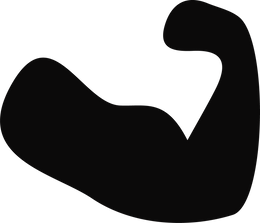 200.000+ Customers Worldwide
200.000+ Customers Worldwide Worldwide Tracked Shipping
Worldwide Tracked Shipping


